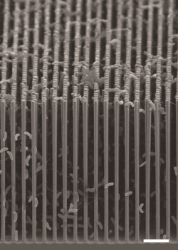
A potentially game-changing breakthrough in artificial photosynthesis has been achieved with the development of a system that can capture carbon dioxide emissions before they are vented into the atmosphere and then, powered by solar energy, convert that carbon dioxide into valuable chemical products, including biodegradable plastics, pharmaceutical drugs and even liquid fuels.
Howard Hughes Investigator and Professor of Biochemistry, Biophysics and Structural Biology Christopher Chang, and Associate Professor of Biochemistry, Biophysics and Structural Biology Michelle Chang were two of the lead authors on the paper titled “Nanowire-bacteria hybrids for unassisted solar carbon dioxide fixation to value-added chemicals.” They, along with the other corresponding author, Dr. Peidong Yang, are also researchers at the Lawrence Berkeley National Lab.
Cross-sectional SEM image of the nanowire/bacteria hybrid array used in a revolutionary new artificial photosynthesis system. Photo courtesy of Peidong Yang.